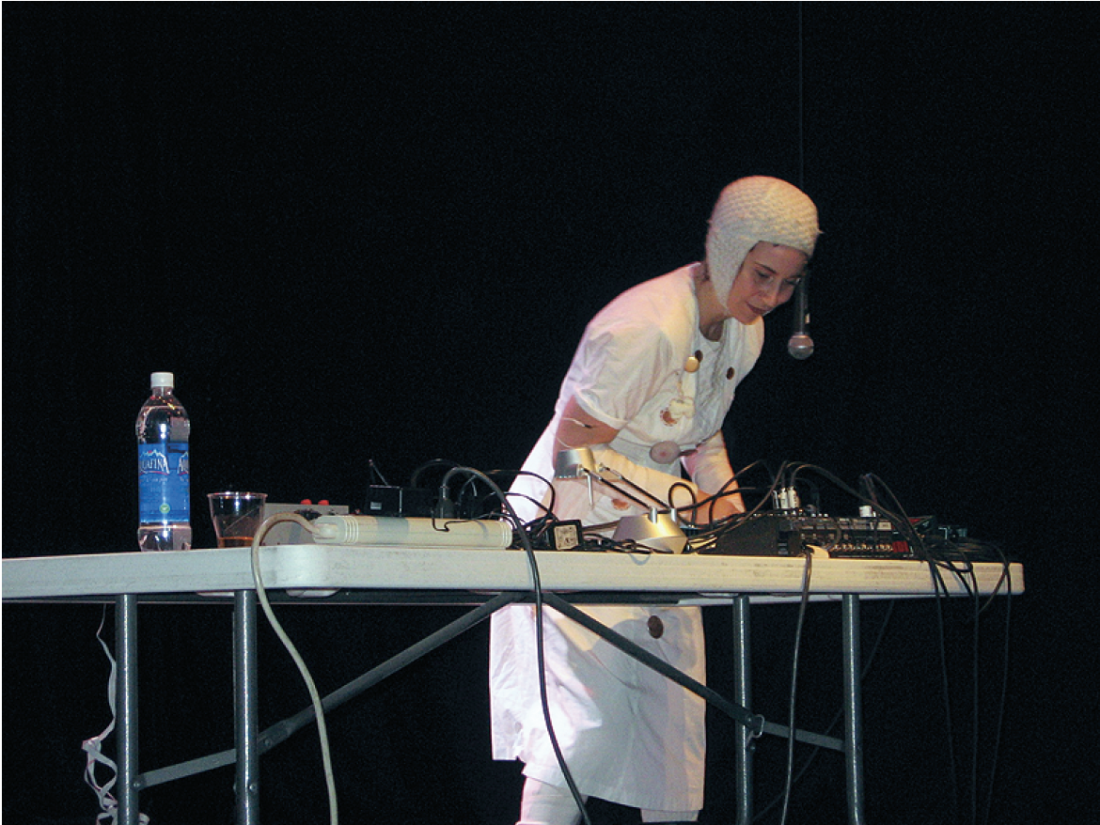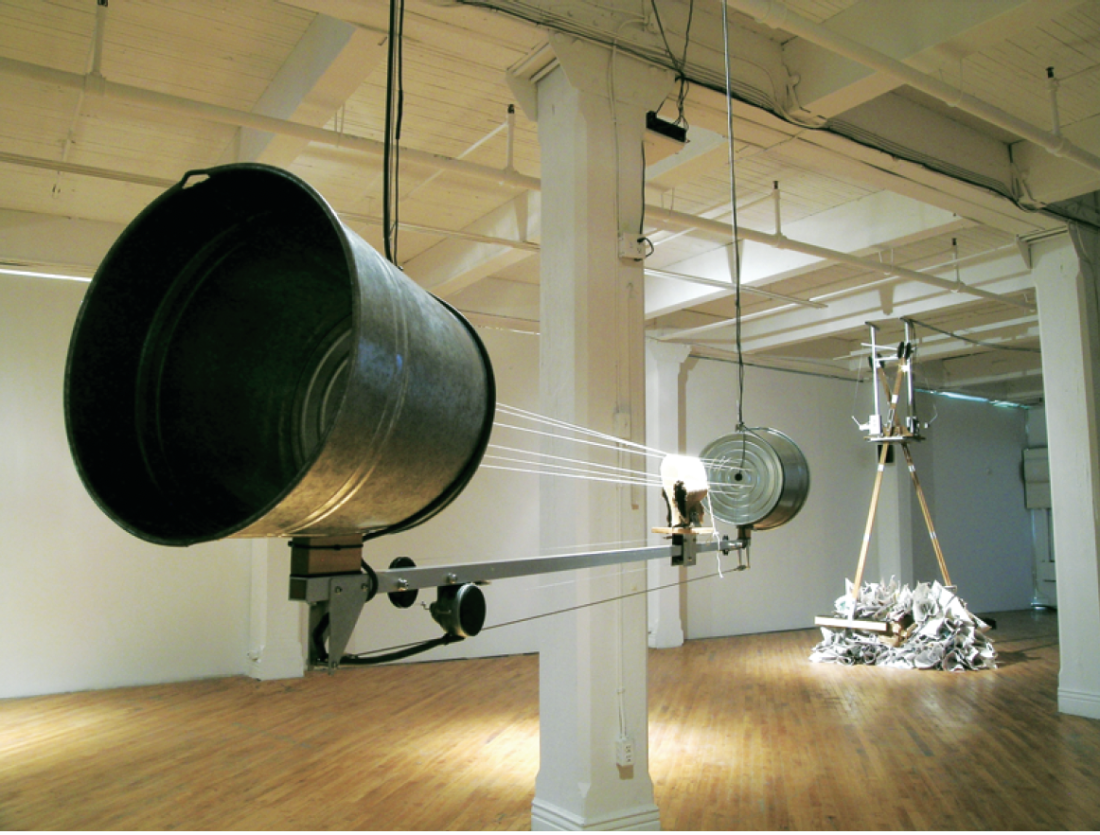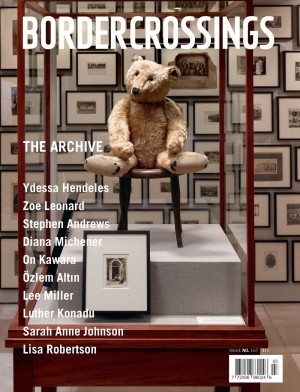“Send and Receive: A Festival of Sound” (version 8)
An elevator creaks and grinds as it carries you up several floors. Cutlery and dishes clink irregularly but persistently in a busy restaurant. Refrigerators and fluorescent lights emit their particular hums. A single passing vehicle produces an evolving cacophony as various sounds reverberate off changing surroundings.
Living amid the contemporary din, we have become adept at tuning out the entire mix. Yet, the dozen or so performances and installations of the eighth annual “Send & Receive” festival had, among their collective effects, a power of revivifying individual elements of the sea of sound in which we find ourselves immersed.
The festival opened with the mesmerizing film projections of New York artist Bruce McClure. On a screen set up in the darkened space of Winnipeg’s West End Cultural Centre, black dots danced, shapes formed and dissolved, patterns merged and diverged, while sound roared, throbbed or was held back—one of the pieces was “silent”—leaving only the chatter of four film projectors.
McClure, who has been working with optical projections since the 1980s, performed pieces from his “Crib and Sift” series. His raw material was four 16mm prints made from a single stretch of clear leader that had been sprayed with black ink. The “sifting” refers to different possible orientations of the film stock as it is fed into the projectors; the “cribbing” involves McClure’s adjusting the focus, concentrating variously on the projectors’ gates, on the film stock itself, or on brass plates with which the projectors have been modified.
For these performances, each component of the cinematic event—the film stock, the light and sound emitted by the projectors, and screen effects made possible by the simultaneous projections— is manipulated. In spite of the well-defined parameters, there are unavoidable and unpredictable variations within and between performances of the same material. McClure says “Crib and Sift” is “a study that devotes itself to the process of disintegration in highly developed structures.”
Then a bonus: McClure also performed Christmas Tree Stand. It begins with a white pulsing orb accompanied by surging noises. The projectors’ on-and-off flicker is accentuated by the use of film loops comprised of dark and light frames in a three-to-one ratio, so that the entire room beats as a stroboscopic chamber. The image evolves into rotating grids and other forms, thanks to the use of perforated metal plates. The relentless sound is filtered through an equalizer and effects pedals.

Alexis O’Hara, Subject to Change, 2005, “Send & Receive: A Festival of Sound.” Photo: Heidi Phillips. Courtesy “Send & Receive: A Festival of Sound.”
No less intense was the four-hour Cassette Memories performance by Japanese artist Aki Onda. Lit only by the shrine-like flickering of 44 candles (which produced a strong scent of beeswax), the Urban Shaman gallery space was at times filled by undulating, rumbling, squealing and hissing sounds at volumes powerful enough to rattle walls—and vibrate internal organs.
Beyond the field of candles, at a cloth-draped table, Onda made occasional tweaks or adjustments. What might have been voices were sometimes audible. The effect was like having been devoured—along with other victims—into the bowels of some infernal machine-complex.
A self-taught electronic musician, composer and producer, Onda has amassed a set of field recordings made with Walkmans. After more than a decade of collecting, he recently began to issue Cassette Memories albums while engaging in a limited number of site-specific performances—which he speaks of as occasions to “play sound memories in a space which has its own memories.”
Eventually, at this particular performance, the wash of sound fades. Traffic can be heard starting up, then moving off. Something’s coming closer. Is that running water? Voices echo as if in a tunnel or underpass. Are people and cars passing overhead?
When the lights finally come up, dozens of labelled audio cassettes can be seen strewn across the table, along with plenty of used nine-volt batteries and empty water bottles. Three Walkman recorders feed through electronic processors and foot pedals into guitar amps. Onda says he likes the warmth of cassette sound, and that old tube amplifiers are better than digital devices for producing results akin to our memories: “distorted and compressed, like fuzzy images wedging themselves into the realm of oblivion.”

Catherine Béchard and Sabine Hudon, Between Sounds And Abstractions, installation view, aceartinc., 2005. Photo: Catherine Béchard.
Collaborators Catherine Béchard and Sabine Hudon, both from Quebec, installed two of their sound-generating constructions at aceartinc. for a project entitled “Between Sounds and Abstractions.” Au Bout Du Fil slowly moves pieces of paper along strings stretched between two metal pails in imitation of the ‘telephone’ device made by children. Contact microphones pick up faint sounds, which are played over speakers. The Voice of Things involves two large brooms—with microphones in their brushes—that sweep back and forth against a pile of newspapers.
Béchard and Hudon are interested in everyday sounds and noises as acoustic material, but also in our impulse to control our technology-laden surroundings. For both installations, motion sensors that register visitors’ presences serve to trigger the mechanisms and to modify the envelope of sound. Yet, the determining factors are not easily discernible, and this prompts the question of how to participate in an environment that is essentially beyond one’s control.
Miniatures Express, a model train performance by Montreal’s Szkieve, involves devices that transform sound and light while transducing various energies into other media. Via electrical transformers, contact microphones, a tiny camera mounted on one of the train cars, and audio and video equipment, electricity is turned into motion, motion is turned back into electrical impulses, and these in turn become amplified sounds and projected images.
As with other events at “Send & Receive,” the means and materials of these transductions were foregrounded. Such performances are less about the effective transmission of any signals and more about the transformations of energy-material, about the transformers themselves and about any transformative effects—upon spaces, participants and audiences.
While Christian Bök’s sound poetry and Alexis O’Hara’s interactive theatre cast the performer’s body as transducer/transformer, Montreal DJ Ghislain Poirier uses turntables to redirect “the big bounce” from vinyl recordings toward the dance floor. Capping off an evening at the Graffiti Gallery with a mix of “big dirty beats” and “ragga style riddims,” Poirier infected the audience with his “art of making people move.” ■
“Send & Receive: A Festival of Sound” (version 8) took place at venues in Winnipeg from October 14 to October 22, 2005, and included performances in Toronto, Ottawa and Montreal later that month.
Phil Koch writes, edits and studies in Winnipeg.

